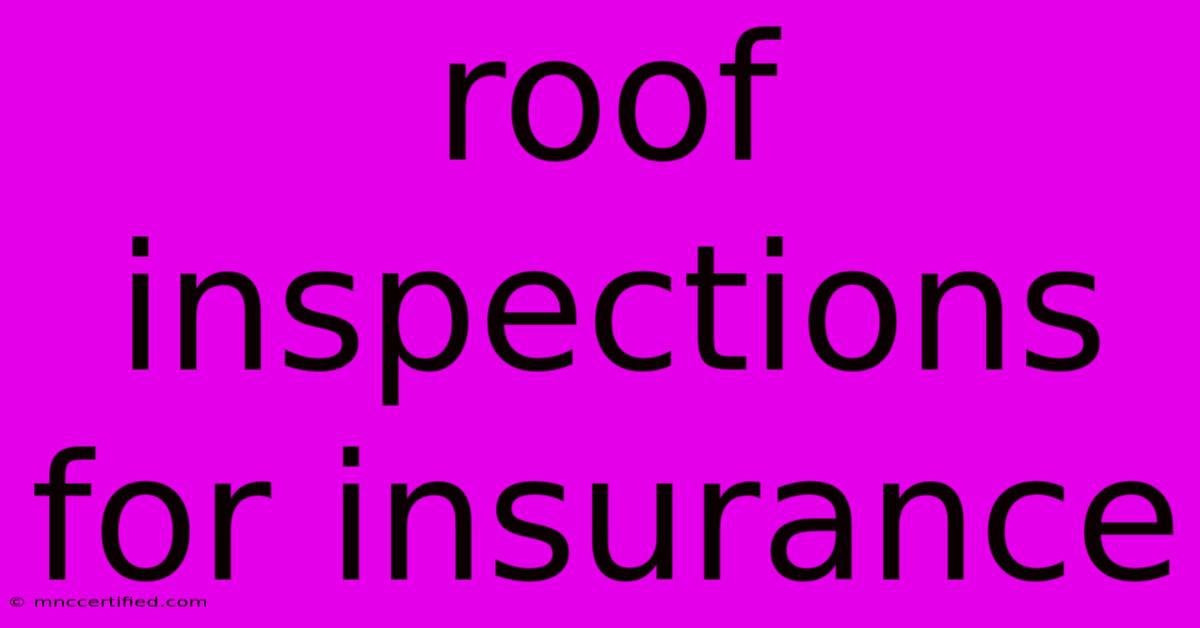Roof Inspections For Insurance

Table of Contents
Roof Inspections for Insurance: A Comprehensive Guide
Getting your roof inspected is crucial, especially when dealing with insurance claims. Understanding the process and knowing what to expect can save you time, money, and a lot of frustration. This comprehensive guide will walk you through everything you need to know about roof inspections for insurance purposes.
Why are Roof Inspections Necessary for Insurance Claims?
Insurance companies require roof inspections to verify the extent of damage and determine the cause. A thorough inspection helps them assess the validity of your claim and determine the appropriate payout. Without a professional inspection, your claim might be delayed, denied, or significantly underpaid. This is especially important after events like hailstorms, strong winds, or wildfires, where widespread damage is common.
Common Reasons for Insurance Roof Inspections:
- After a storm: Hail damage, wind damage, or even fallen tree limbs can cause significant roof damage, requiring an inspection to assess the extent of repairs needed.
- Pre-purchase inspection: When buying a house, a roof inspection is vital to identify potential problems and avoid costly surprises after closing. Many insurance companies will require this as part of the underwriting process.
- Regular maintenance: Even without apparent damage, regular roof inspections can help identify minor issues before they escalate into major, costly problems. This proactive approach can help prevent future claims and maintain your insurance coverage.
- Leak detection: Persistent leaks often require a professional roof inspection to locate the source of the problem and determine the necessary repairs.
What to Expect During a Roof Inspection for Insurance
The inspection process usually involves a qualified and licensed roofing professional, often chosen by your insurance company or a contractor they approve. They'll thoroughly examine your roof, looking for various types of damage. This usually includes:
Key Aspects of a Professional Roof Inspection:
- Visual assessment: The inspector will visually inspect the entire roof from the ground and, if safe and accessible, from the roof itself. They'll look for missing or damaged shingles, cracks, punctures, and any signs of water damage.
- Material evaluation: The type of roofing material, its age, and overall condition are crucial factors. Different materials have different lifespans and susceptibility to damage.
- Drainage system check: Gutters, downspouts, and flashing are vital for proper water drainage. Blockages or damage in these areas can contribute to roof problems.
- Underlayment inspection: The inspector will assess the underlayment, a waterproof layer beneath the shingles, to check for damage that may not be visible from the outside.
- Documentation: A thorough report, complete with photos and a detailed description of the findings, is essential. This report serves as the basis for your insurance claim.
Preparing for Your Roof Inspection
Being prepared for the inspection will streamline the process and ensure a smoother experience.
Steps to Take Before the Inspector Arrives:
- Clear the area: Remove any obstacles, such as furniture, debris, or toys, that might impede the inspector's access to your roof.
- Gather relevant documentation: Have your insurance policy, previous roof repair records, and any relevant photos readily available.
- Communicate clearly: Clearly communicate any known issues or concerns you have about your roof to the inspector.
- Be present: If possible, be present during the inspection to answer questions and provide additional information.
Understanding the Insurance Claim Process After the Inspection
Once the inspection is complete, the inspector will provide a detailed report to your insurance company. The insurer will then review the report and determine the extent of coverage. This may involve a negotiation process, especially if there are discrepancies in the assessment of damages.
Navigating the Claim Process:
- Review the report carefully: Make sure the report accurately reflects the damage to your roof.
- Negotiate with your insurer: If you disagree with the insurance company's assessment, be prepared to negotiate or seek additional opinions from other qualified professionals.
- Keep records: Maintain meticulous records of all communication, reports, and documentation related to your claim.
Getting a roof inspection for insurance purposes is a crucial step in protecting your property and ensuring a fair claim settlement. By understanding the process and taking the necessary steps, you can significantly increase your chances of a successful outcome.

Thank you for visiting our website wich cover about Roof Inspections For Insurance. We hope the information provided has been useful to you. Feel free to contact us if you have any questions or need further assistance. See you next time and dont miss to bookmark.
Featured Posts
-
Trumps Tariffs Mexico Canada China
Nov 27, 2024
-
Notre Dame Basketball Game Preview
Nov 27, 2024
-
A Better Deal Insurance Agency
Nov 27, 2024
-
Saracens Chief Resigns After 10 Months
Nov 27, 2024
-
Reduced Mortgage Rates Barclays
Nov 27, 2024